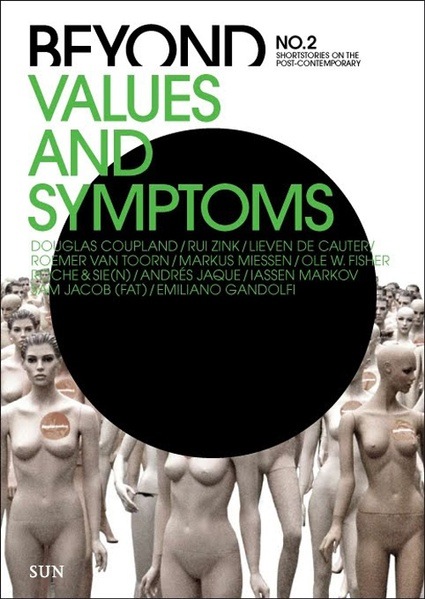Beyond no.2 – Values and Symptoms. Short Stories on the Post-Contemporary, edited by Pedro Gadanho and published by Sun Architecture (available on Amazon USA and UK.)

Beyond is a hybrid between a magazine and a book, publishers gave the format the rather inelegant name of ‘bookazine’. The first issue was about Scenarios and Speculations, the third one focuses on Trends and Fads. Beyond offers a platform for new, experimental forms of architectural and urban writing that so far didn’t exist in newspaper, magazines, or academic literature. Editor Pedro Gadanho invites theorician, writers, philosophers, art historians, designers, curators and of course architects to come up with texts of fiction such as short stories, extracts from travel diaries, exquisite corpse or graphic novels that would present and comment on architectural and urban space thinking. I received Beyond a couple of months ago, abandoned it on a bookshelf to gather dust, grabbed it on my way to the airport, forgot it in my suitcase and only opened it out of intense boredom the other day on the Eurostar. I read it from back to back with enthusiasm and i’m looking forward to get my hands on the other issues. Not only is the reading entertaining and diversified but some of the text depicts and illuminate key issues and themes of architecture and urban space better than many more factual articles and essays would do.
The contributors for this issue are Douglas Coupland, Roemer van Toorn, Sam Jacob, Andrés Jaque, Francois Roche, Triin Ojari, Markus Miessen, Iassen Markov, Ole W. Fischer, Lieven de Cauter, Emiliano Gandolfi, Rui Zink, Nuno Coelho & Adam Kershaw, Bert de Muynck and Marc Schuilenburg.
The theme of the issue i’ve just read is ‘Values and Symptoms’: “The uncertainty of the present moment, accompanied by symptoms as fear, social imbalance and cynicism defines an interesting turning point. We need to question which are the values we want to pursue and represent in the urban landscapes of today. Where do we find the groundings on which to rebuild pragmatic optimism and shared goals for our daily life?” says editor in chief Pedro Gadanho. The stories included in this volume not only address current symptoms such as fear and paranoia, but also offer unexpected visions on how to deal with old urban issues such as war, gentrification, and capitalistic city growth.
A quick run through some of the texts i particularly liked:
In a poignant account of his visit to Palestinian territories during the Riwaq biennial Lieven de Cauter exposed how much his concept of heterotopia can be applied to Israel and the territories it occupies in Palestine, Rui Zink wrote a brilliant short story about a mysterious Pavilion of the Future which people enter excruciatingly slowly and never seem to ever emerge from. Nuno Coelho and Adam Kershaw produced a series of drawings that readers are invited to “colour in”, they show Palestinian refugee camps, an Israeli settlement in the Palestinian territories, bring side by side a representation of the Berlin wall and of the walls that emprison Palestinian. The result comment on the social tensions of daily life in the region and proposes an alternative approach to exploring the Arab-Israeli conflict (more information about A Land Without People for a People Without Land.) François Roche and R&Sie propose a quite compelling exquisite corpse where green monsters meet designers on a Russian submarines cemetery, Sam Jacobs tells the story of a director of character animation who looses his mind while trying to work on a representation of the assassination of President Kennedy, Ole W. Fischer offers “A Short History of the Post-Condition in Architecture.”
Image on the homepage from the project Decolonizing Architecture.
